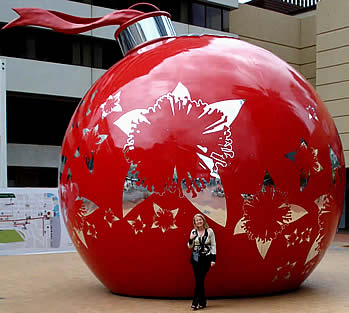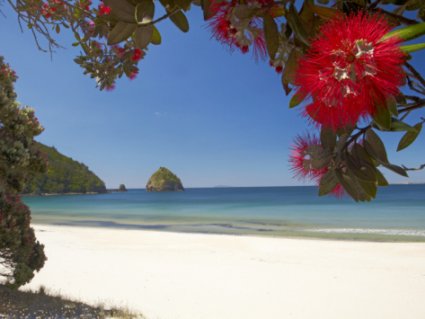New Zealand Christmas Tree
The Pohutukawa (Metrosideros excelsa) is a coastal evergreen tree in the myrtle family, Myrtaceae, that produces a brilliant display of red flowers made up of a mass of stamens. The Pohutukawa is one of twelve Metrosideros species endemic to New Zealand. Renowned for its vibrant colour and its ability to survive even perched on rocky, precarious cliffs, it has found an important place in New Zealand culture for its strength and beauty and is regarded as a chiefly tree (rakau rangatira) by Maori. The Pohutukawa is popular in cultivation, and there are fine examples in most North Island coastal cities. Vigorous and easy to grow, the tree flourishes well south of its natural range, and has naturalised in the Wellington area and in the north of the South Island. It has also naturalised on Norfolk Island to the north.
The Pohutukawa is popular in cultivation, and there are fine examples in most North Island coastal cities. Vigorous and easy to grow, the tree flourishes well south of its natural range, and has naturalised in the Wellington area and in the north of the South Island. It has also naturalised on Norfolk Island to the north.
In 1833 the missionary Henry Williams described holding service under a ‘wide spreading pohutukawa’. The first recorded reference to the pohutukawa as a Christmas tree came in 1867 when the Austrian geologist Ferdinand von Hochstetter noted that settlers referred to it as such. The pohutukawa, he observed, ‘about Christmas … are full of charming … blossoms’; ‘the settler decorates his church and dwellings with its lovely branches’. Other 19th-century references described the pohutukawa tree as the ‘Settlers Christmas tree’ and ‘Antipodean holly’.
In 1941 army chaplain Ted Forsman composed a pohutukawa carol in which he made reference to ‘your red tufts, our snow’. Forsman was serving in the Libyan Desert at the time, hardly the surroundings normally associated with the image of a fiery red pohutukawa tree. Many of his fellow New Zealanders, though, would have instantly identified with the image.
Today many school children sing about how ‘the native Christmas tree of Aotearoa’ fills their hearts ‘with aroha’.
Merry Christmas from all the team at StudyNewZealand.eu








